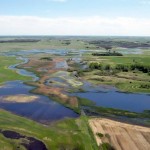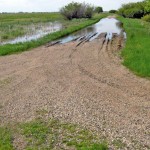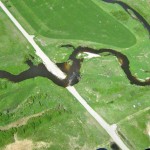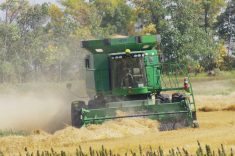Heavy rainfall isn’t the only reason overland flooding is washing out roads and resulting in hundreds of thousands of acres left unseeded in southwestern Manitoba this year, provincial officials say.
Manitoba Infrastructure and Transportation Minister Steve Ashton said last week the province now has proof illegal drainage in Saskatchewan is exacerbating the problems faced by downstream landowners and municipalities.
Last week the RMs of Albert, Edward and Arthur declared states of emergency, as roads washed out and residents felt the full brunt of heavy rainfalls calculated at 200 per cent of normal between April, May and the first part of June.
Read Also

Mazergroup’s Bob Mazer dies
Mazergroup’s Bob Mazer, who helped grow his family’s company into a string of farm equipment dealerships and the main dealer for New Holland machinery in Saskatchewan and Manitoba, died July 6 from cancer.
Ashton referred to a recently released University of Saskatchewan study during a flood update last week, saying it clearly shows that southwestern Manitoba’s water woes directly result from drainage activities to the west.
“This study really validates what people in the southwest have been saying. We have clear evidence in a very high-level study… that illegal drainage is having an impact,” Ashton said.
The study is a multi-year computer modelling study of the Smith Creek watershed, done at the university’s Centre for Hydrology, testing several scenarios, including what run-off would look like if wetlands were restored to late 1950s levels, and if they were drained completely. Its conclusion: there is a direct link between wetland drainage and peak stream flows during a flood.
The region has seen a decrease in wetland coverage in the past 50 years from 24 per cent to 11 per cent.
“We found that wetland drainage has a very strong impact on stream flow in flood conditions,” said John Pomeroy, director of the Centre for Hydrology and Canada Research chair in Water Resources and Climate Change, which conducted the research.
“For the 2011 flood, complete restoration of the wetlands to their historic levels decreases the flood peak that year by nearly a third. Conversely, complete drainage of wetlands increased the 2011 flood peak by 78 per cent.”
- Aerial photo of the RM of Edward shows the wet conditions that have made roads impassable and left farmers in the region unable to seed.
- Roads have been washed out or left impassable by high rainfall and wet conditions in the RM of Edward which declared a state of emergency June 5.
- An aerial view of flooding in the RM of Edward.
Steve Topping, the province’s executive director of hydrologic forecasting and water management called the study “a significant piece of work.” He plans to table the study with the Prairie Province’s Water Board to discuss what actions must be taken now that these wetlands are gone.
Potential actions could include building channels on existing waterways and improving the efficiency of existing drains, he added.
“That basin has had a significant loss of wetlands due to artificial and enhanced drainage by private landowners,” he said. “A significant increase in volume of water is passed on and generated in the system due to artificial drainage.”
Ashton said Manitoba has raised the issue with the Saskatchewan government.
“We are asking them (Saskatchewan) to do what we are doing in this province,” he said.
- More from the Manitoba Co-operator: Changes to drainage regulations on tap
“They are moving on it, but until they have the same kind of approach, our concern is the continued deterioration of wetlands and continued development of illegal drainage will make it (flooding) worse.”
Farmers in southwestern Manitoba have once again been inundated by water this spring. Pastures are flooded out, thousands of acres will go unseeded. Municipalities have yet to tally the damages to washed-out roads or left impassable.
Provincial authorities say approximately 25,000 to 30,000 acres of cropland won’t be seeded in the upper Assiniboine Valley region as the river once again exceeds its banks. The root causes of this now annual occurrence must be addressed or this entire region faces an uncertain future, say local municipal leaders.
“We are in over our head,” said Debbie McMechan, a councillor in the RM of Edward, which declared its state of emergency June 5.
“It’s going to take people with a lot more resources than what we’ve got to understand this problem.”
There have been discussions this spring towards forming an organizational body to address water management in the Assiniboine River basin region. That initiative has been taken on by the Prairie Improvement Network formerly called the Manitoba Rural Adaptation Council, which wants to see a partnership formed by governing groups, farmers and academia that would span Manitoba, North Dakota and Saskatchewan and work towards sustainable water management in the Qu’Appelle, Souris, and Assiniboine river basins.
Manitoba also released its own surface water strategy last week to help stem further wetland losses here as well as overhaul drainage licensing (see related story page 3).























